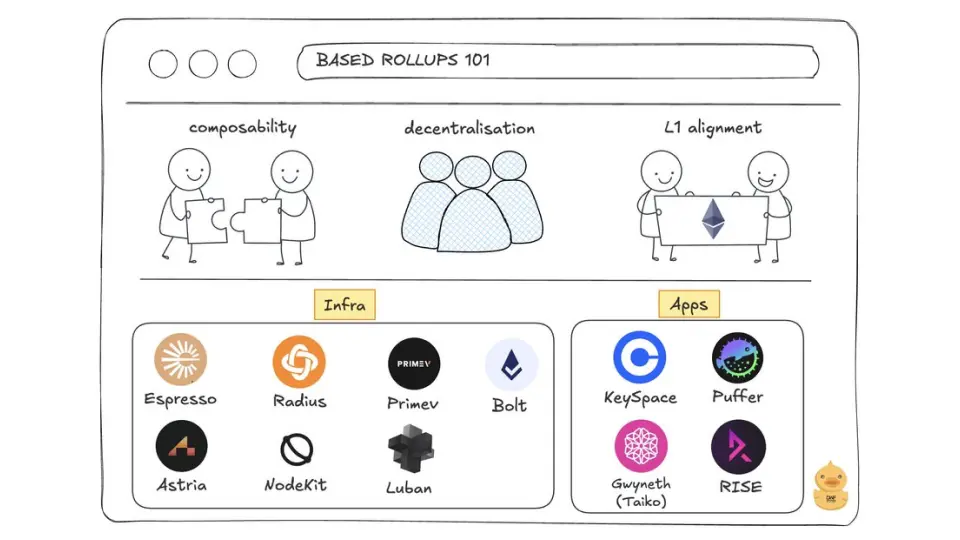
- Details
As Layer 2 (L2) solutions for Ethereum continue to grow, the blockchain space has faced a new issue: centralisation and liquidity fragmentation, with over 74 L2s live, and even more to be launched. This article explores how the emergence of based rollups could alleviate these issues, and some of the most prominent applications of this technology.
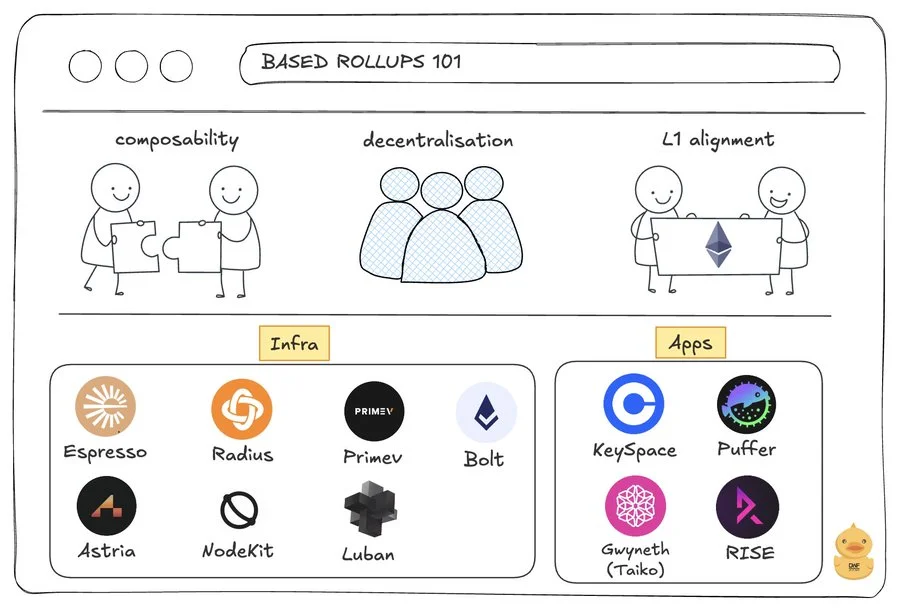
First Off: What is a Based Rollup?
Before we dive into the based rollups, let’s revisit the very concept. Rollups are L2 scaling solutions for Ethereum that process transactions off-chain, ensuring reduced transaction costs compared to the base L1 blockchain.
Initially, there were optimistic and zero-knowledge (ZK) rollups. They both bundle multiple transactions and submit them as a single transaction to Ethereum’s main chain to achieve both high scalability and security.
Based rollups represent a more recent evolution of rollups, offering enhanced decentralisation and security by using Ethereum's validators for transaction sequencing. The latter is a process of ordering and organising transactions within a blockchain before they are confirmed and added to a block.
Sequencing is responsible for determining how and when transactions are included in the blockchain, affecting the performance and security of the network. In Ethereum, sequencing is typically managed by validators that bundle transactions from a mempool (a queue of pending transactions) and include them in blocks. In rollups, transaction sequencing is often handled by an entity known as a sequencer, which puts multiple transactions in bundles off-chain before submitting the batch to the base layer (Ethereum).
By using L1 validators, based rollups remove reliance on centralised sequencers and allow for better economic alignment between the L1 and L2 layers. With such a design, based rollups benefit from Ethereum's native consensus, offering pre-confirmations and making transaction settlement faster and more secure.
Based Rollups vs. MEV and Centralisation
One of Ethereum's key goals is reducing centralisation, particularly in the context of Maximum Extractable Value (MEV). MEV refers to the potential profit that can be extracted by controlling the order of transactions within a block, which has increasingly concentrated in the hands of centralised entities.
Based rollups offer a solution by minimising the reliance on centralised L2 sequencers, and instead, introducing decentralised block building and pre-confirmations for better user experience (UX).
In based rollups, L1 block proposers replace L2 sequencers, allowing them to include a rollup block in an L1 block in a permissionless manner. This process is significant as it improves decentralisation and ensures greater system liveness: as more L1 proposers get involved, the risk of chain outages and censorship is significantly reduced.
Pre-confirmations
Pre-confirmations is another emerging technology, crucial for understanding based rollups. This concept refers to a system where transactions receive an initial confirmation before they are fully finalised on the L1's main layer. With pre-confirmations coming to based rollups, users get a ‘confirmation’ that their transaction is likely to succeed within seconds, even though the final settlement and inclusion in the L1 chain may take more time.
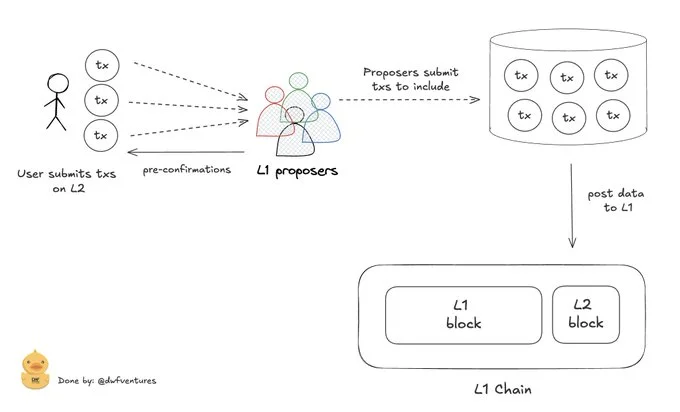
Shared Sequencing
Currently, L2 networks generate revenue through transaction fees and MEV, but these revenues often flow back to teams due to the centralised nature of sequencers. In contrast, based rollups distribute value back to the L1, while also adding value through shared sequencing.

Shared sequencing is a method for processing transactions across multiple rollups in a decentralised manner, aiming to reduce centralisation risks and improve cross-rollup compatibility. Instead of each rollup using its own sequencer, shared sequencing allows different rollups to submit their transactions to a common network of sequencers, which passes them to an L1 blockchain.
Shared Sequencing Marketplaces
Espresso Systems is developing a marketplace where rollups can sell sequencing rights to block proposers. This allows multiple proposers to participate in a single block, creating competition on price. As a result, rollups can earn more revenue as proposers bid above a reserve price to secure sequencing rights.
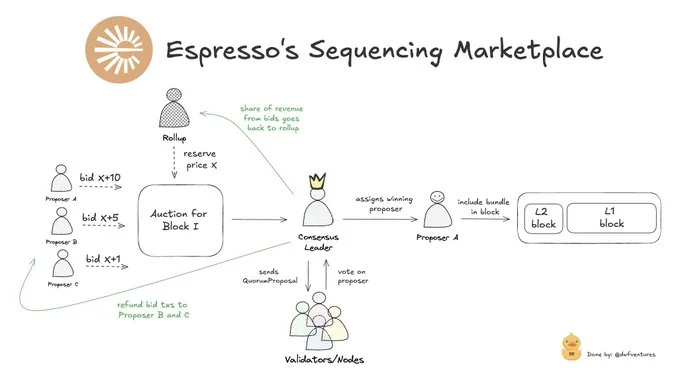
Other notable protocols working on similar infrastructure include Astria, Radius, and NodeKit. Together, they help lay the groundwork for a more decentralised and efficient rollup ecosystem.
Appchain Frameworks
One more application of based rollups is building application-specific blockchains, or appchains. An appchain is a blockchain designed and optimised for specific applications or use cases. Unlike L1s and L2s, appchains allow developers to tailor the blockchain’s architecture, governance, and consensus mechanisms to fit the unique requirements of their dapp or ecosystem. Rollups come in handy as part of an appchain infrastructure, enabling better scalability and security while maintaining the flexibility required for fine-tuning the appchain.
Rollup-based appchains are usually built with frameworks. Some of the popular examples include Polygon Supernets and Avalanche Subnets.
Spire is another player advancing the appchain framework, but with a focus on based rollups, specifically. Their based rollup framework empowers developers to create their own based appchains that are interoperable with L1 liquidity. The composability between different appchains allows users to enjoy a seamless experience without needing to bridge assets between different chains. Spire’s framework uses based rollups’ features we described, such as pre-confirmations and shared sequencing.
Cross-Chain Composability
Coinbase has also ventured into the based rollup space with its KeySpace project, which enables smart wallets to become cross-chain under a single address, simplifying cross-chain interactions and making DeFi more accessible to ordinary users.
Similarly, Taiko is another based rollup that aims to achieve synchronised composability between L1 and L2 blockchains, as well as between different L2s. This feature will allow for better arbitrage and MEV opportunities, with more value being directed back to the base layer.
Better UX and Yield Opportunities
Puffer Finance is working on a based rollup called UniFi, which offers users faster transactions through pre-confirmations and enhanced yield generation from rollup fees. Additionally, UniFi users have access to liquidity across other based appchains without fragmentation.
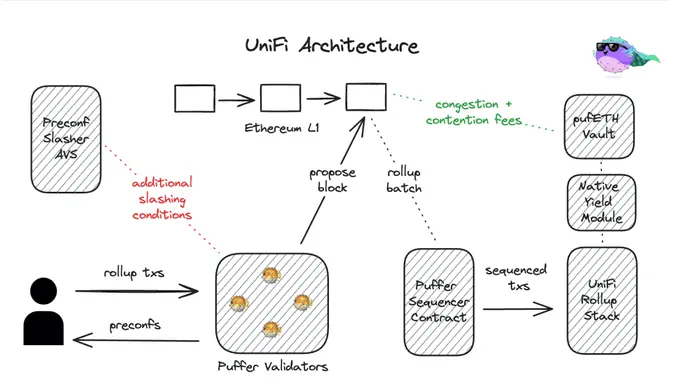
Overall
Although the infrastructure for based rollups is still in its early stages, several key developments are already laying the foundation for a more decentralised and efficient blockchain ecosystem. Aimed at overcoming some of the weaknesses of other rollup models, such as transparency and centralisation risks, based rollups are a pivotal addition to the rollups tech.
With the growing number of appchains and protocols adopting the based rollup model, the entire rollup ecosystem could experience exponential growth. If you’re building in this space and want to collaborate with DWF Ventures, reach out to us directly.
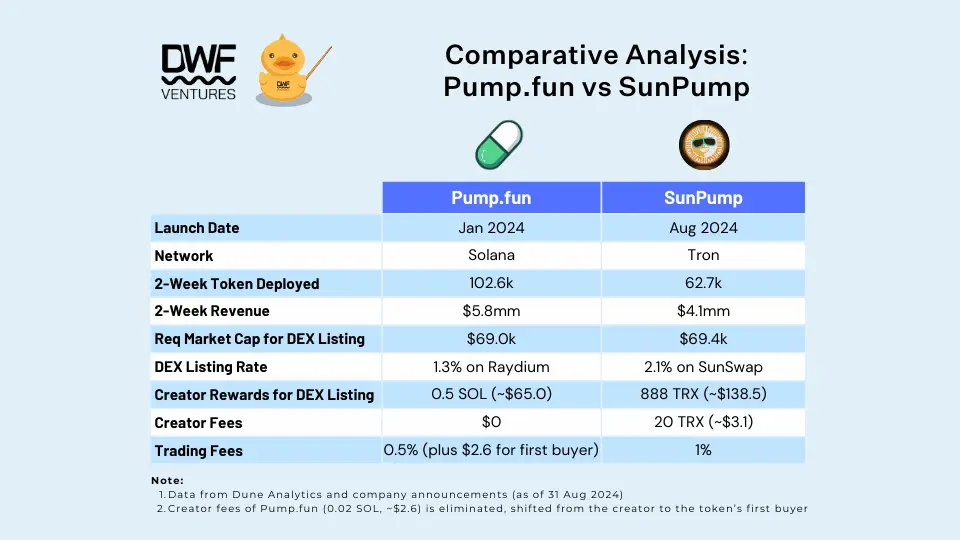
- Details
Memecoin launchpads have gained significant traction in the crypto market, especially with the recent surge in the popularity of SunPump. Alongside Pump.fun, these platforms are emerging as leaders in the memecoin launchpad space. We took a closer look at both projects, their mechanisms, and market performance to make a comprehensive comparison. Here is the short summary:
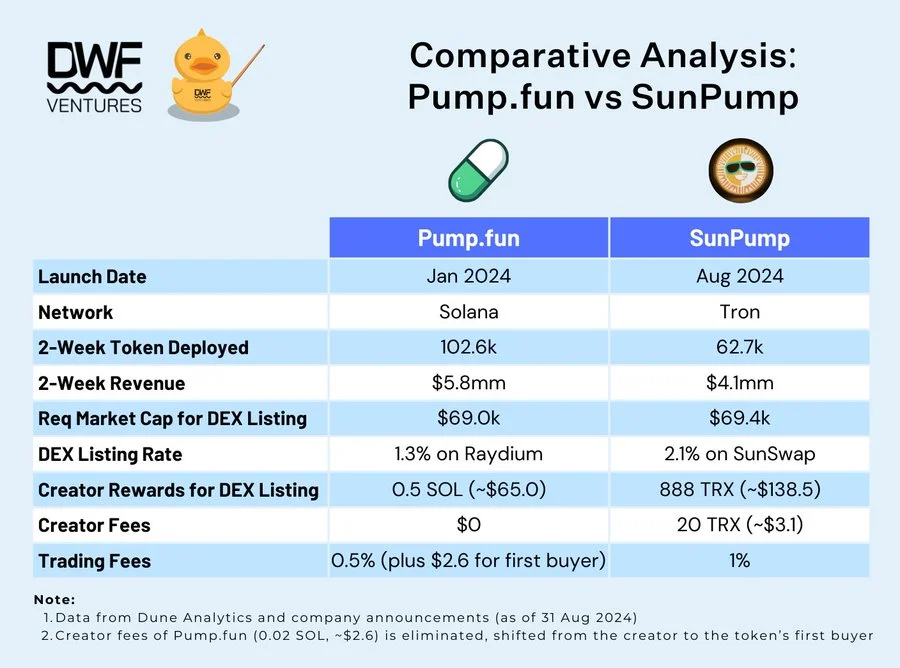
Why Are Launchpads So Important for Memecoins?
Memecoin launchpads provide tools for fast and easy issuance of new memecoins, simplifying the entire process for individuals without technical expertise. These platforms are crucial for the memecoin ecosystem as they lower the barriers for token creation and trading, while also providing essential liquidity through bonding curve models that adjust token prices based on demand.
Solana vs. Tron: Ecosystems Clash
This year has been marked by fierce competition between Tron and Solana for the leading role in the memecoin market.
Launched in early 2024 on Solana, Pump.fun quickly reshaped the entire memecoin landscape. At some point in May, 83% of all the tokens created on Solana were issued using Pump.fun, with daily average revenue exceeding $1 million.
To challenge Pump.fun’s dominance, Tron’s creator Justin Sun backed the SunPump launchpad on Tron, which went live a few months after its rival, in August. Within two weeks of the launch, SunPump managed to surpass Pump.fun in daily activity and revenue; however, Pump.fun retook first place shortly afterwards.
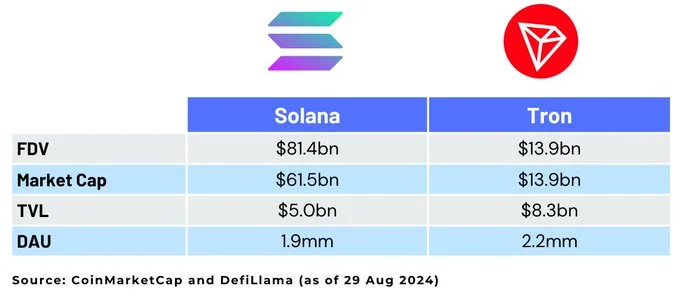
Bonding Curve Mechanism Explained
One important mechanism driving memecoin launchpads is a bonding curve model, employed by both Pump.fun and SunPump. Its purpose is to maintain liquidity and market-based pricing of memecoins.
The bonding curve model ensures that, as more people buy into a new memecoin, the token’s price increases along a predefined curve. Once the market cap reaches $69,000, $12,000 worth of liquidity is deposited into decentralised exchanges (DEXs) like Raydium Protocol (for Pump.fun) or SunSwap (for SunPump) and then get burnt.
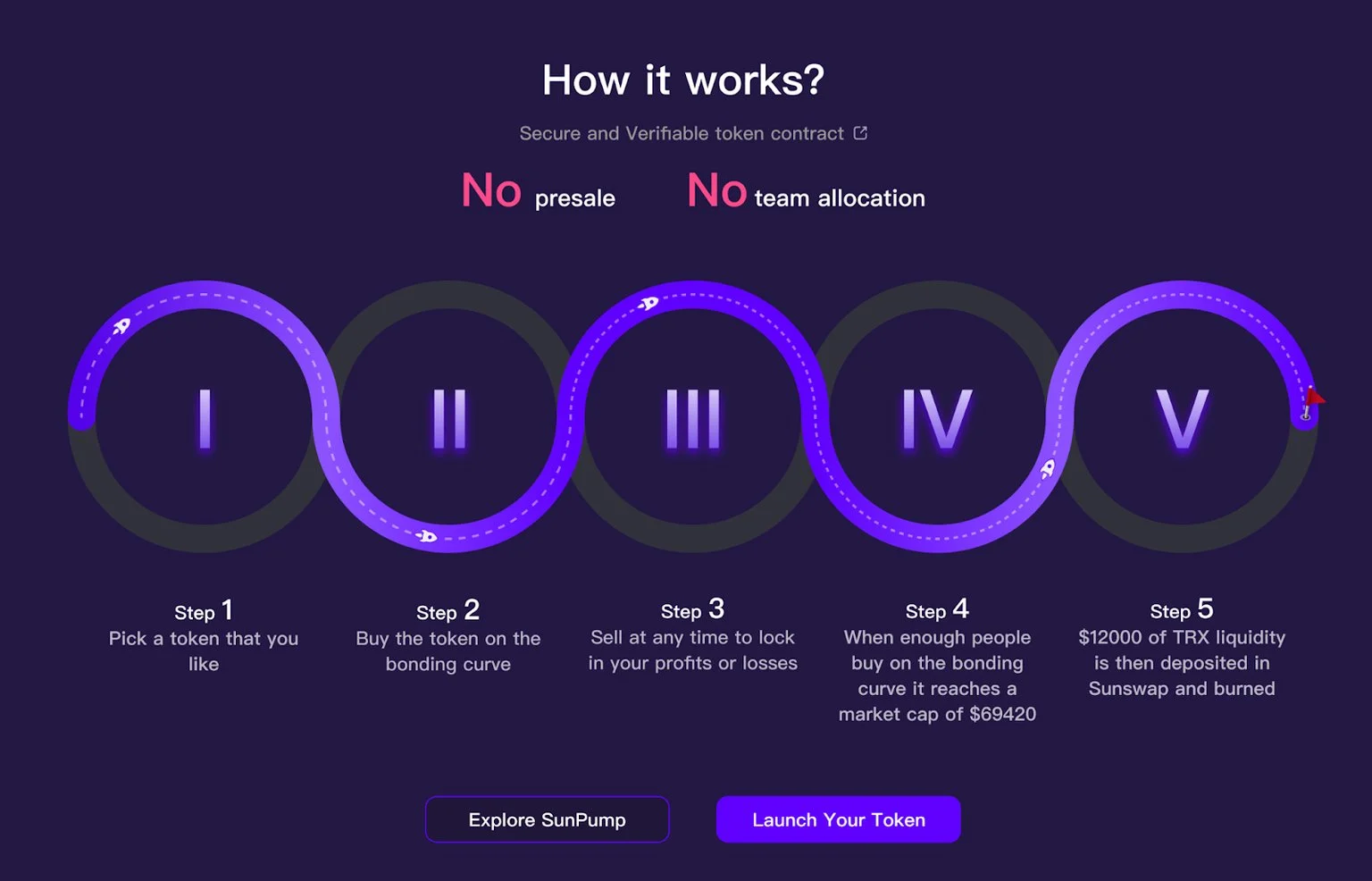
DEX Conversion Rates
One of the critical measures of success for any memecoin platform is its DEX conversion rate—the percentage of total tokens that successfully convert into tradable assets on decentralised exchanges. Both Pump.fun and SunPump have struggled with relatively low conversion rates: 1.4% and 2.1%, respectively.
Although these figures may seem modest, they highlight the broader challenge within the memecoin launchpad ecosystem: while it is easy for creators to launch memecoins, fostering a thriving community and securing a DEX listing remains daunting tasks.
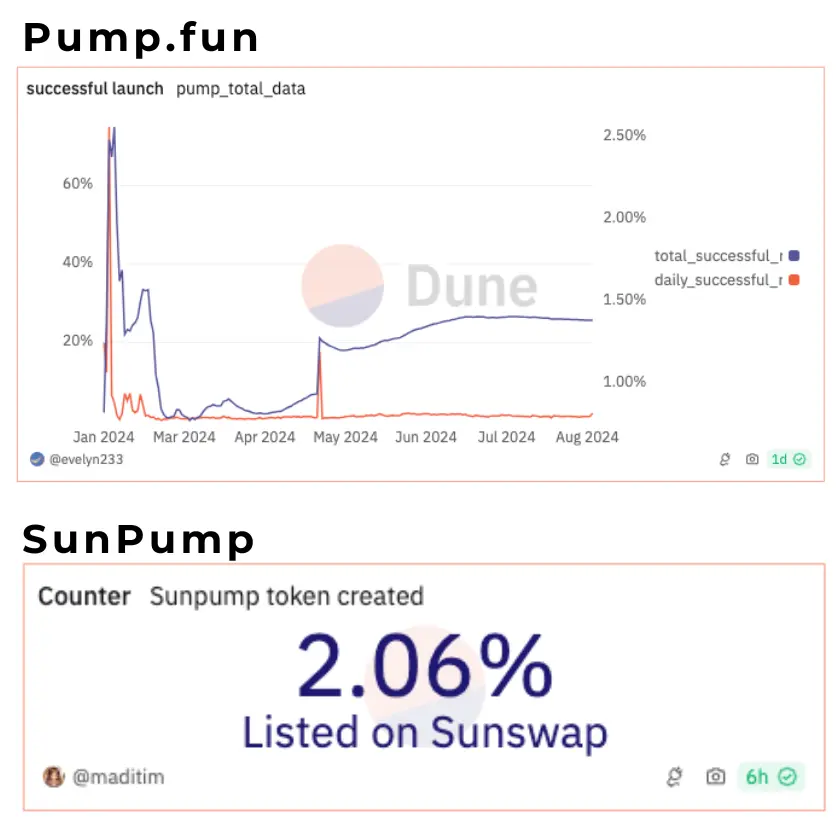
Deployed Tokens and Revenue
The total number of tokens created on the platforms, as well as their dynamics, is a vital metric and an indicator of user engagement. In the mere months following its launch, Pump.fun achieved impressive numbers, with 1.9 million tokens deployed and $105 million generated in revenue (go to this Dune Analytics dashboard for up-to-date numbers). SunPump, despite its recent entry, is catching up to Pump.fun at an impressive pace:
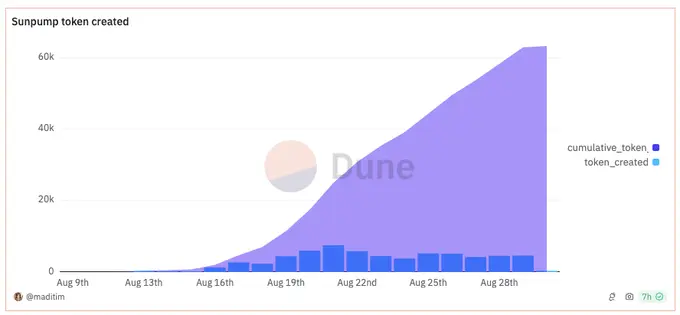
Creation Fees
Fees collected by launchpads are a critical competitive advantage of one protocol over another. Initially, Pump.fun charged creators a fee of approximately $2.60 (0.02 SOL) to launch a memecoin, which was mirrored by SunPump upon its launch. However, in a strategic move, Pump.fun eliminated creation fees (along with introducing a 0.5 SOL reward for a creator if their token completes the bonding curve) on the same day SunPump launched. Instead, this fee is now paid by the first buyer.
Memecoin Launchpad Market Expansion
The memecoin launchpad market is becoming more crowded, with several other notable players entering the space. Platforms like Jupiter Exchange LFG, Game.com, Ethervista, We.Rich, and Ticket.Fans have all made strides in creating their own unique memecoin launchpad ecosystems.
Multi-Chain Memecoin Launchpads
Apart from Solana and Tron, other blockchains like Ethereum, TON, Base, and BNB Chain are also becoming home to memecoin launchpads. The future of this space could lie in multi-chain platforms, which allow creators and traders to operate across different blockchains, accessing a broader audience and liquidity.
Overall
As memecoin launchpads continue to grow, Pump.fun and SunPump are leading the charge with their innovative models and strong community support. While Pump.fun has a head start, SunPump is rapidly catching up, and the broader market is becoming more competitive by the day. If you happen to build in the same space and would like to contact DWF Ventures, feel free to reach out.
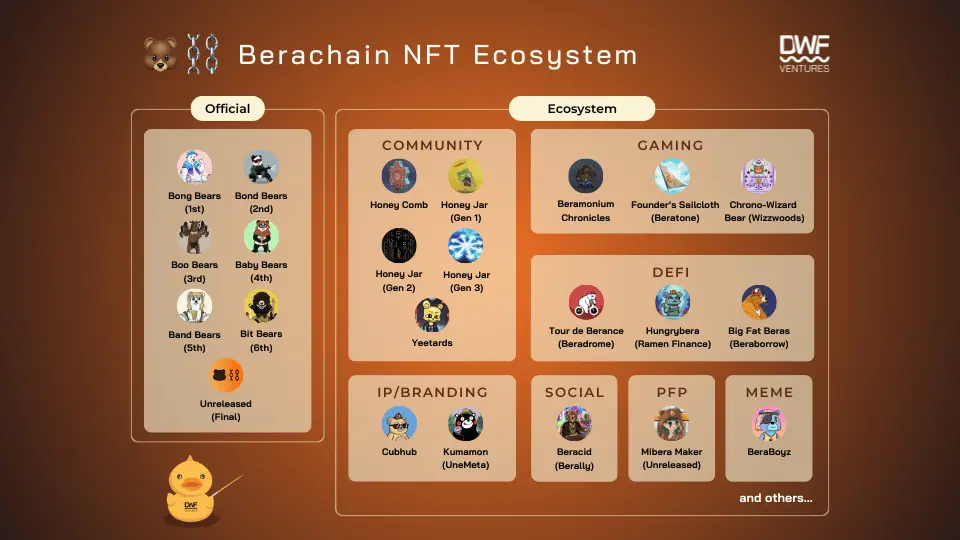
- Details
Berachain's upcoming mainnet launch has spurred significant excitement on the NFT market, which experienced a significant surge in floor prices over the past weeks. Explore the diverse and rapidly evolving NFT ecosystem within the Berachain network in our article.
Berachain: Why the Hype?
Berachain is an emerging L1 blockchain built on the Cosmos SDK and designed to be fully compatible with the Ethereum Virtual Machine (EVM). What sets Berachain apart is its Proof-of-Liquidity (PoL) consensus mechanism, which allows users to stake assets like Ethereum (ETH) or stablecoins to secure the network. Validators are rewarded based on the liquidity they bring to the network, which in turn enhances both network security and liquidity. This represents a unique approach compared to how the validation works in traditional Proof-of-Stake (PoS) networks.
Three Native Crypto Assets
Berachain employs a three-token model comprising:
- BERA, a native token used for paying gas (transfer fee).
- BGT, non-transferable governance token in the form of NFT.
- HONEY, a stablecoin backed by USDC reserves.
Such a system of tokens is intended to balance network incentives between security, governance, and liquidity provision.
Liquidity Bootstrapping
Berachain focuses on liquidity bootstrapping. The PoL mechanism encourages users to lock liquidity in return for governance rights and rewards, bringing more motivation into decentralized governance.
Active Community
Since the launch of the Artio testnet in January 2024, Berachain has attracted over 200 dapps and processed millions of transactions. Its user-friendly developer experience, EVM compatibility, and cross-chain capabilities make it highly attractive for builders.
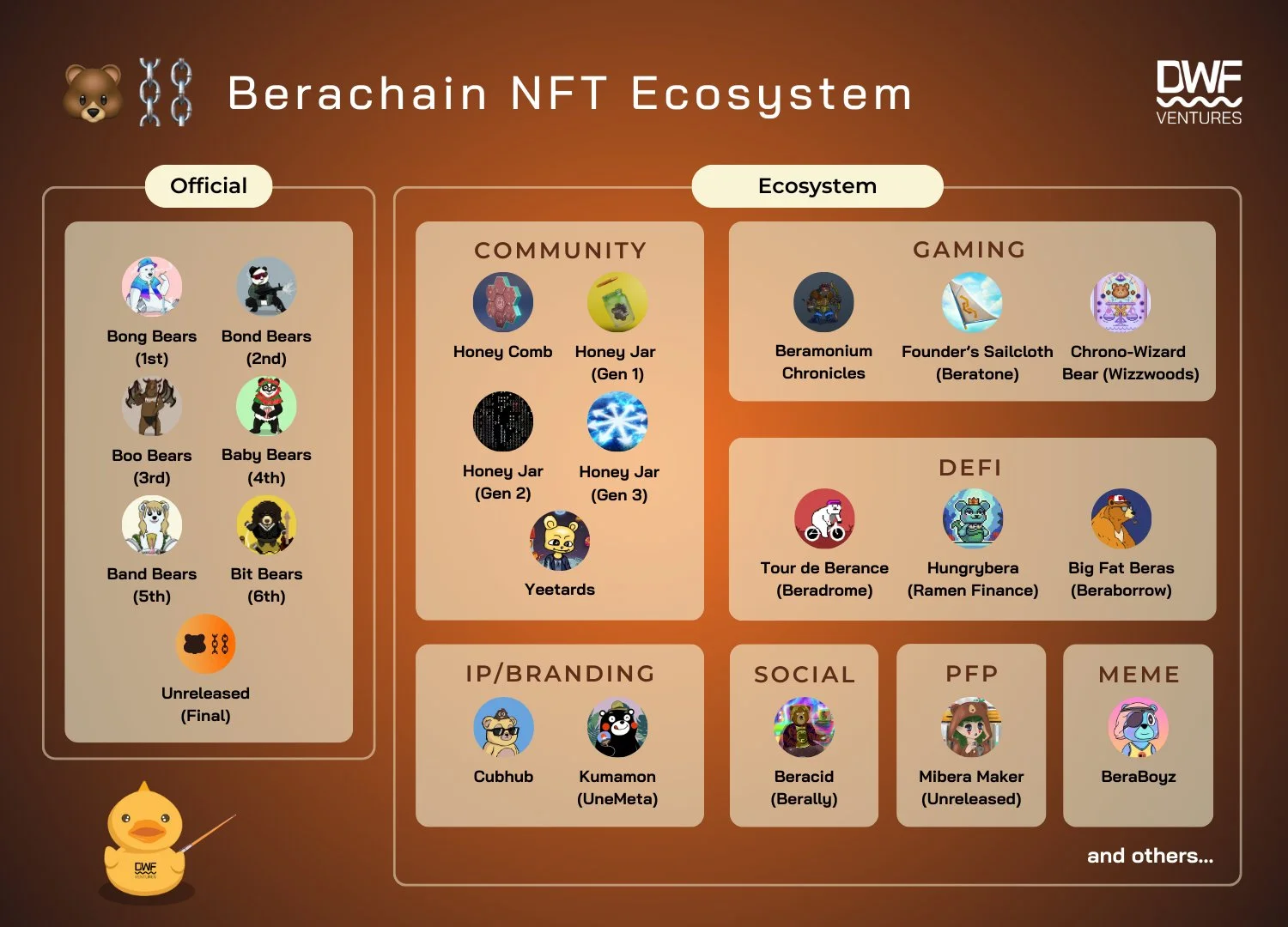
NFT Collections
Initially started as an NFT collection called Bong Bears, Berachain has kept its grassroots origin, creating a culture where NFTs are integral to this blockchain ecosystem. Particularly, Berachain’s PoL consensus mechanism enhances the utility of NFTs within the ecosystem: NFTs offer exclusive access to various DeFi functionalities, rewards, and governance roles, making them more than just digital art.
Official Berachain NFT Collections
The first Berachain’s official NFT collection, Bong Bears, pioneered the rebasing NFT collections, of which six have been released so far. The concept of rebasing came to the NFT space from DeFi. It refers to a dynamic adjustment of the supply or attributes of NFTs based on certain conditions or external factors.
The final rebase of Bong Bears is expected to coincide with Berachain’s mainnet launch. While not officially confirmed, there is speculation that holders of these official NFTs could be among the ones, or those with the most chances, to receive airdrop from Berachain.
Whether this rumor will come true or not, current holders have already benefited from various perks, including allowlist spots and discounted or free mints for other NFT projects within the ecosystem.
Ecosystem NFTs
Berachain carries a number of ecosystem NFT collections that can be broken down into several categories: Community, Gaming, DeFi, Branding, Social, Profile Picture (PFP), and Meme. Here are utilities for some of the collections leading in the Community and Gaming groups:
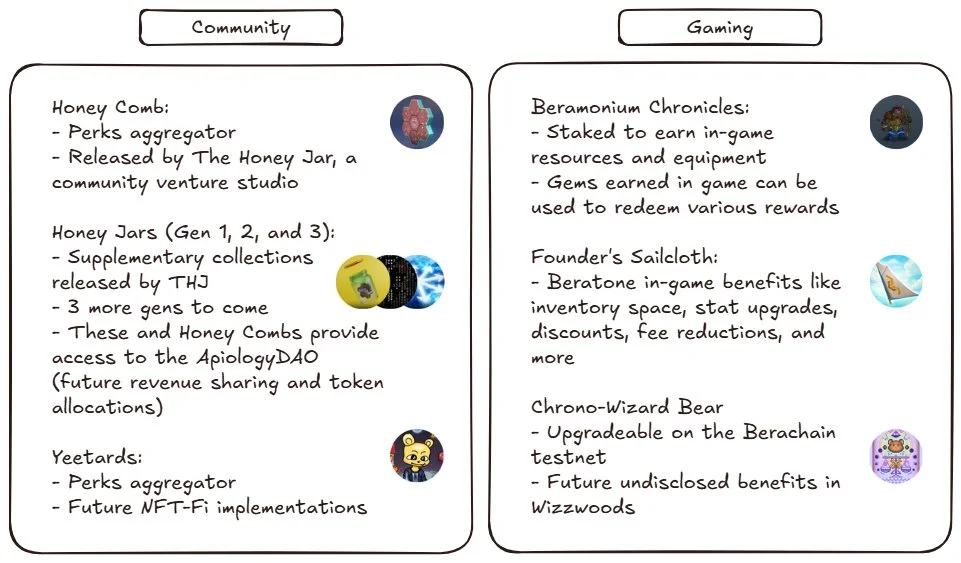
Most tokens have airdrops, early access to features, and revenue sharing. However, NFTs under the PFP and Meme categories do not usually have such utilities:
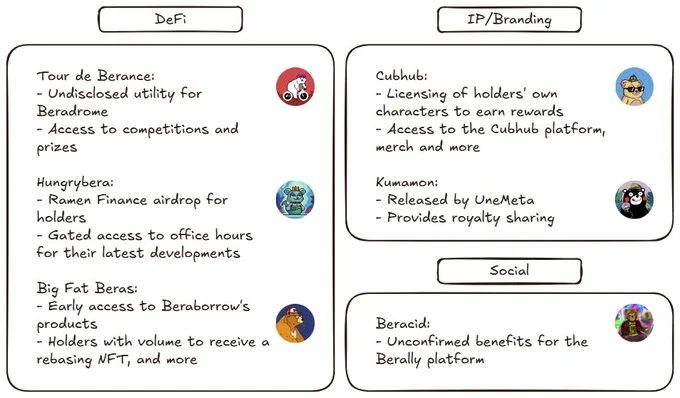
Overall
With its unique consensus algorithm, several native crypto assets, and broader utility for NFTs, Berachain is one of the most promising chain launches this year. The speculation surrounding a potential airdrop ahead of the mainnet is further fueling interest. And while we have covered a multitude of NFTs building on Berachain, this list is non-exhaustive and not a complete depiction of the rich and growing ecosystem.
If you build on Berachain and are searching for a crypto VC firm to support you on your journey, feel free to contact DWF Ventures.
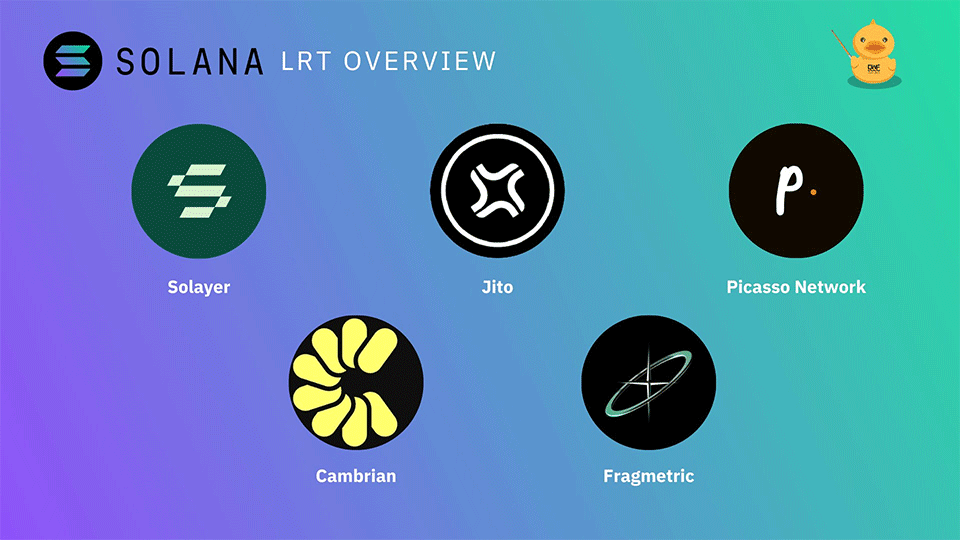
- Details
Liquid Restaking Token (LRT) services had been at the forefront of attention in the Ethereum ecosystem, but the focus has since shifted to Solana, with a number of notable projects seeing the light. Read further if you want to learn more in the new article by the DWF Ventures team.
Why Liquid Restaking Became Popular
Staking has always been a key feature of any Proof-of-Stake blockchain, serving as the backbone of its validation process and consensus mechanism.
Liquid staking became the next step for users aiming to enhance capital efficiency: instead of just locking cryptocurrency in a staking contract, they also get a liquid staking token (LST) to further deploy in DeFi protocols for additional yield―hence the “liquid.”
The largest, and, probably, the most prominent liquid staking protocol responsible for popularizing this approach is Lido, which alone accounts for about 30% of all the staked Ethereum (ETH) market, as of August 2024.
On Solana, Jito leads the liquid staking scene, commanding around 50% of the market with its LST, jitoSOL, followed by Marinade (~16% of staked SOL; mSOL token), Jupiter (~10% share with jupSOL), and others.
Now, we’re observing a new mechanism: liquid restaking tokens (LRTs), striving to ensure even higher profitability. LRT allows you to stake your LSTs, receiving a second “layer” of tokens that can also be used in DeFi. While this technique comes with more financial complexity and higher risks, liquid restaking still appeals to users due to higher yields.
LRT Services on Solana
Solayer
Launched in mid-May 2024, Solayer has attracted significant attention, amassing over $190 million in TVL with 4 live endoAVSs.
Endogenous Actively Validated Services (AVSs), or endoAVS, allows a Solana-native dapp to optimize network operations according to its stake size, ensuring faster and more reliable user transactions.
In other words, with endoAVS user transactions are accelerated based on the stake ratio, inducing higher yields to attract stakers. Validators with a higher stake have a correspondingly higher priority for executing their on-chain transfers.
Picasso Network
Built on the Cosmos SDK, Picasso Network operates as a bridge between Solana and Cosmos, enabling cross-ecosystem security through multi-asset restaking. Essentially, this allows cross-ecosystem messages sent via Cosmos’ Inter-Blockchain Communication Protocol (IBC) to be secured by leveraging the economic security of Solana.
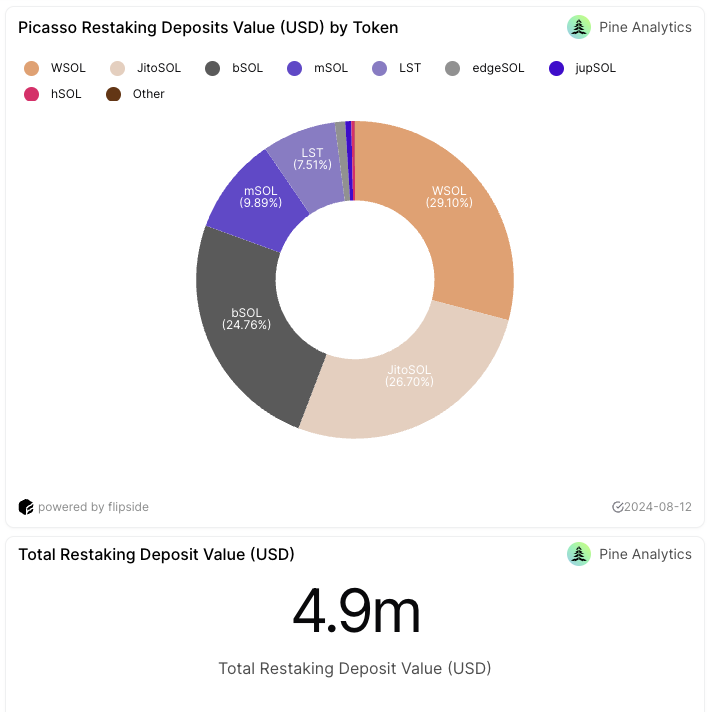
The project claims to be pioneering the first interoperability solution of its kind, while also positioning itself as the first “generalized restaking layer.”
Using IBC, Picasso facilitates exchange of data between various blockchain platforms. This isn’t limited to just asset transfers: IBC can handle messages, contract calls, and even fee transfers. The Picasso team views IBC as a more secure alternative to traditional cross-chain solutions.
And, unlike EigenLayer, Picasso has been striving to build a “generalized” restaking service, which allows for restaking assets across multiple chains.
Since its launch in January 2024, Picasso Network has gained around $4.9 million in TVL.
Jito
In late July, Jito introduced Jito Restaking, a multi-asset service consisting of two key components: the Vault Program and the Restaking Program.
Vaults are designed for operations with Liquid Restaking Tokens (VRTs) by Node Consensus Operators (NCN), including their minting, burning and delegation across operators, as well as customizing slashing conditions for risk management.
The Restaking Program, on the other hand, serves as a unified interface for a wide range of operations. It supports both staking and restaking, allowing users to manage NCNs, enhance token utility, establish insurance funds, and scale base layers. Essentially, it’s a one-stop shop for maximizing the efficiency of AVSs while improving staking versatility.
It will be interesting to watch how things unfold, especially with:- the potential shift of JitoSOL liquidity toward restaking;
- the partnership with Renzo, which could introduce EVM liquidity into the ecosystem;
- the adoption of NCNs across the board, particularly through Solana’s SPL token standard.
Other Noteworthy Projects
We have a couple more projects to highlight. First is Cambrian, which is focused on creating a “modular security layer” for Solana. In this framework, SOL holders validate new software modules being developed on the network. In Cambrian's vision, restaking provides economic security, not just for dapps but also for entire chains running on Solana.
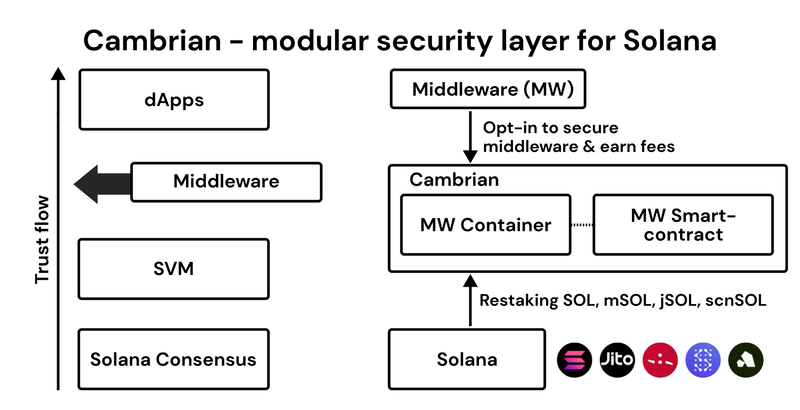
Fragmetric is another liquid restaking protocol currently in development, using fragSOL as its Liquid Restaking Token (LRT). Though still in the works, it's expected to play a significant role in the expanding restaking ecosystem.
Conclusion
With the liquid restaking space growing, we obviously anticipate new tech and mechanisms, along with the increase of competition in this niche for the Solana ecosystem in the coming months.
We always look for innovative web3 projects. If you happen to be building in the LRT space and are looking into partnering with a tier-one venture capital firm, feel free to reach out to DWF Ventures directly.
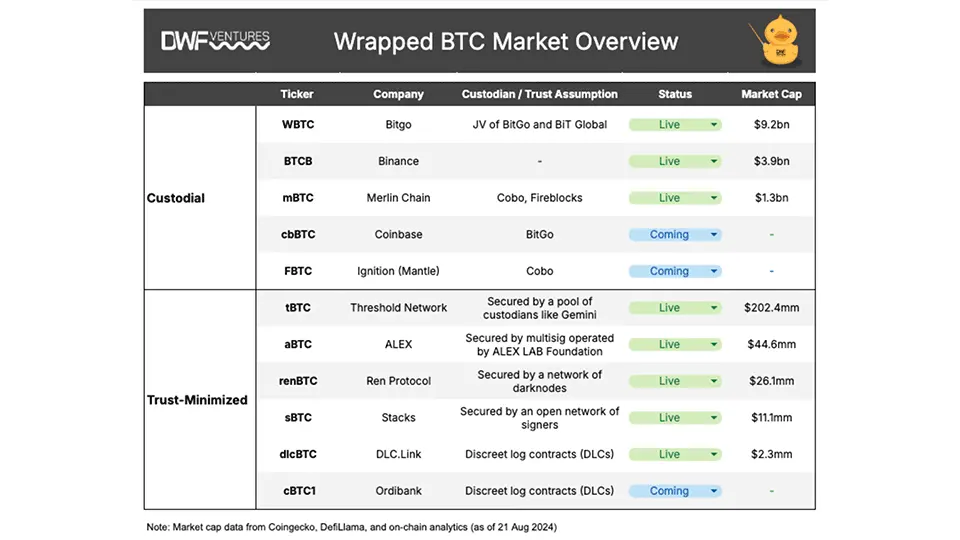
- Details
After BitGo announced the transition of its wrapped Bitcoin (WBTC) custody earlier this month, the market of wrapped BTC assets has again come into the spotlight. Although having a high adoption in the Ethereum DeFi ecosystem, WBTC is not the only such project. And just recently, crypto giants Coinbase and Mantle consequentially announced the launch of cbBTC and FBTC, respectively.
DWF Ventures’ team has researched on the wrapped BTC market and compared a list of available options:
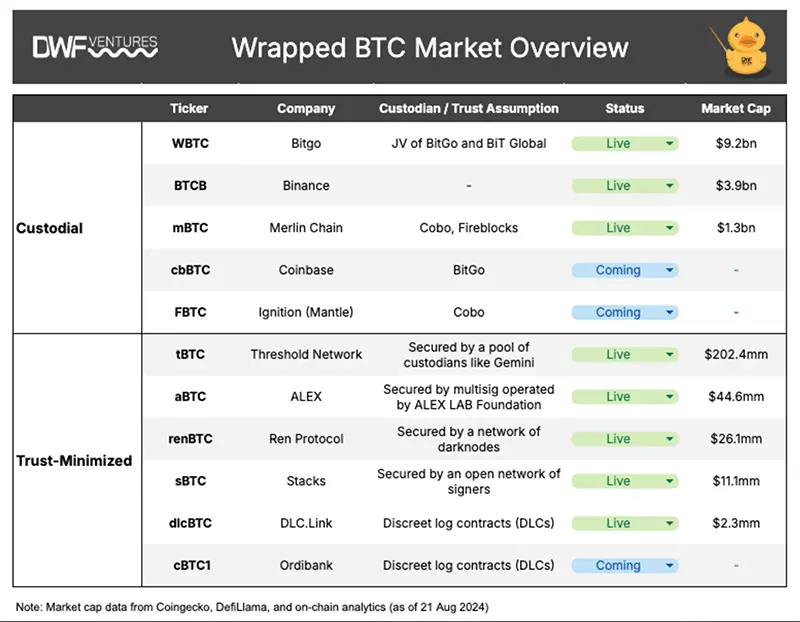
Top LRT Protocols
How Does Wrapped Bitcoin Work?
A wrapped Bitcoin is a version of Bitcoin (BTC) that operates on other blockchains, such as Ethereum or BNB Chain, in the form of a fungible token. The main purpose of a wrapped Bitcoin is to make BTC accessible in dapps running on their respective networks.
WBTC is an ERC-20 version of BTC. It has gained wide adoption, because it allows Bitcoin holders to participate in the global DeFi ecosystem, which is primarily centered around Ethereum. WBTC enables the integration of Bitcoin into various protocols, including lending, borrowing, yield farming, and others.
Ultimately, WBTC bridges the gap between the two largest blockchain ecosystems, bringing Bitcoin’s value into the more flexible Ethereum space.
Types of Wrapped BTC Assets
There are two main types of wrapped BTC tokens:
- Custodial. These crypto assets rely on centralized entities to manage the underlying BTC reserves. A custodian, usually being a company, holds the actual bitcoin and issues the corresponding wrapped tokens. Users trust the custodian with maintaining a 1:1 peg between the wrapped asset and bitcoin in reserves. The primary benefit of custodial tokens is that they are generally easier to manage and have stronger liquidity, albeit carrying counterparty risks.
- Trust-minimized. Trust-minimized wrapped BTC tokens eliminate or reduce reliance on a single custodian by utilizing decentralized protocols, cryptographic security, or a network of signers. These assets are designed to offer a more decentralized and secure alternative to custodial models. But, while they reduce third-party risk, these cryptos may face technical complexities and lower liquidity compared to custodial solutions.
Custodial Wrapped BTC Projects
Wrapped Bitcoin (WBTC)
Site: https://wbtc.network/
WBTC is a custodial wrapped bitcoin token, managed by BitGo in partnership with BIT Global. Launched in 2019, WBTC boasts a market cap of $9.2 billion (as of August 21, 2024), making it the largest wrapped BTC asset. WBTC enables bitcoin to be used in DeFi apps across various chains, with a major stake in Ethereum. It maintains its liquidity through partnerships with numerous exchanges and DeFi protocols.
Bitcoin BEP2 (BTCB)
Issued by Binance, BTCB is a custodial wrapped BTC token designed for BNB Chain and its DeFi ecosystem. Binance directly holds the bitcoin reserves for BTCB. With a market cap of $3.9 billion, BTCB is widely used within Binance’s platforms for trading, staking, and lending purposes, such as PancakeSwap and Thena Fusion. BTCB’s liquidity and reliability stems from Binance's dominance in the crypto space.
Merlin BTC (mBTC)
Site: https://merlinbtc.com/
Managed by an L2 EVM Merlin Chain, which focuses on building the DeFi ecosystem of BTC-based assets and dapps, mBTC is its main bitcoin-pegged token, secured by custodians Cobo and Fireblocks. The asset’s market cap has reached $1.3 billion by the end of August 2024.
Coinbase BTC (cbBTC)
The wrapped bitcoin market would not be complete without the participation of the main US crypto exchange Coinbase, which sounded the plans to launch cbBTC on its Ethereum L2 called Base just a week ago. We anticipate the company will likely partner with BitGo in this endeavor, although no other details nor the launch date have been disclosed to the public yet.
Ignition (FBTC)
Site: https://fbtc.com/
FBTC is an “omnichain” custodial token offering exposure to bitcoin, launched in July 2024 by Mantle with Cobo serving as the custodian. It is distinctive from other wrapped BTC projects by offering a cross-chain asset, transferable using the proprietary bridge (hence “omnichain”). In just a month, FBTC managed to surpass the $100 million TVL mark, promising a wider adoption for this cryptocurrency. At the moment, you can trade it on Uniswap, Agni Finance or Merchant Moe platforms.
Trust-Minimized Wrapped BTC Tokens
tBTC
Site: https://tbtc.network/
tBTC is a wrapped bitcoin token backed by Threshold Network that leverages a decentralized network of signers instead of a single custodian. It is secured by a network of participants, including major names like Gemini. With a market cap of over $200 million and around $70 million of TVL, tBTC has emerged as a viable decentralized alternative to custodial solutions. Threshold Network works as a “decentralized custody” for the asset, with any user having the ability to mint tBTC using collateral, and redeem it back.
ALEX BTC (aBTC)
aBTC is a trust-minimized token running on the Stacks blockchain, locked in a multisignature crypto wallet controlled by the ALEX LAB Foundation. Its market cap was about $44.6 million in August 2024, providing holders of aBTC with a decentralized BTC derivative for use in DeFi apps.
sBTC (Stacks Bitcoin)
Site: https://sbtc.tech/
sBTC is a non-custodial wrapped BTC token, issued on the Stacks network. It is secured by an open network of signers and serves the growing Stacks ecosystem, which integrates bitcoin’s security features with smart contracts. In particular, all transactions within Stacks are finalized in the bitcoin network, bringing an additional security layer. The project currently has a market cap of $11.1 million.
dlcBTC
Site: https://www.dlcbtc.com/
dlcBTC is a wrapped BTC token, protected by the so-called discreet log contracts (DLCs), a cryptographic method that enhances security and privacy. Aimed at institutions rather than retail users, it allows a depositor to create “storages” for the locked bitcoins that can only be accessible by the owner. dlcBTC’s current market cap is $2.3 million.
cBTC1 (Ordibank Bitcoin)
cBTC1 is an upcoming token, pegged to bitcoin and managed by the cross-chain lending protocol called Ordibank. It utilizes the same DLC technology for cBTC1’s collateral. One notable Ordibank’s specifics is its support of the experimental BRC-20 token standard for bitcoin.
Overall
Although WBTC remains the largest and most widely adopted asset on the wrapped Bitcoin market, new entrants like Coinbase's cbBTC and Mantle's FBTC highlight increasing competition. These tokens increase opportunities for Bitcoin holders to participate in a wider DeFi ecosystem. As the DeFi market matures, more solutions, from centralized custodians to decentralized protocols, will appear to provide flexibility in accessing Bitcoin-based assets across different networks.
If you are looking for a crypto VC partner, feel free to contact DWF Ventures.
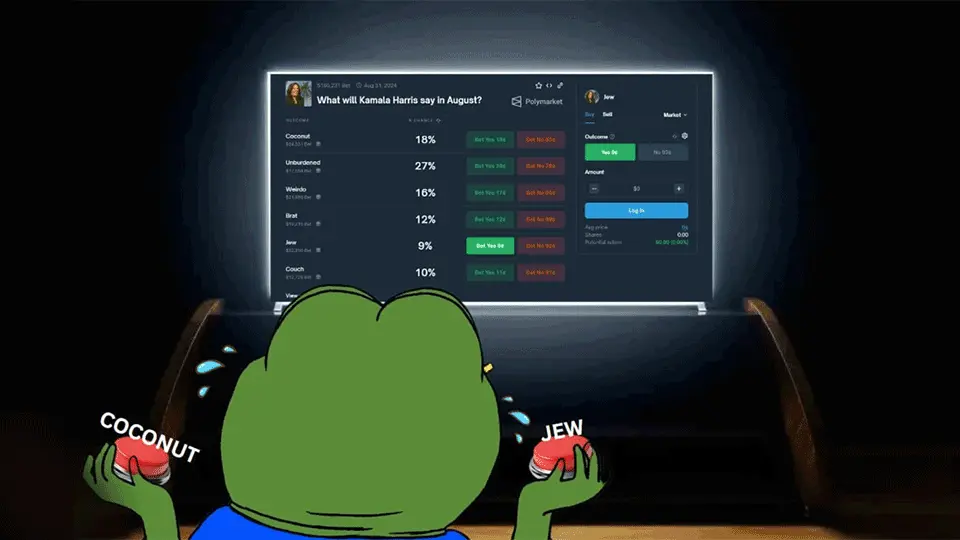
- Details
As media and social platforms get more polarized, prediction markets are gaining traction due to their fun and, potentially, profitable offering to bet on real-world events, such as elections. In this article, we will explore the existing prediction protocols, their core mechanics, and outline some future developments.
What is a Prediction Market in Crypto?
Prediction market is a platform for trading contracts based on the outcome of future events, such as elections, sports, or economic indicators. Prices in these markets reflect the collective probability of specific outcomes, as determined by traders' buying and selling activities.
Although prediction markets were present long before the first blockchain saw the light, they gained renewed popularity with the advent of blockchain technology due to its decentralized, transparent, and trustless nature. Blockchain eliminates the need for intermediaries, reduces fraud risk, and ensures that contracts are executed automatically via smart contracts. This increased transparency and security have made prediction markets more accessible and reliable for a global audience.
Why Polymarket Became so Popular in 2024
The leading protocol on the prediction market is Polymarket. It has been around since 2020, but has only been seeing the growth of its user base and activity starting from this year due to the bet on US presidential elections. Trump and Harris go very close in polls, making it hard to predict the outcome, which drives the activity on Polymarket.
Polymarket’s total value locked (TVL) has grown tenfold YTD, from $9 million to $90 million, with high numbers of both new and (especially) returning users of the protocol.
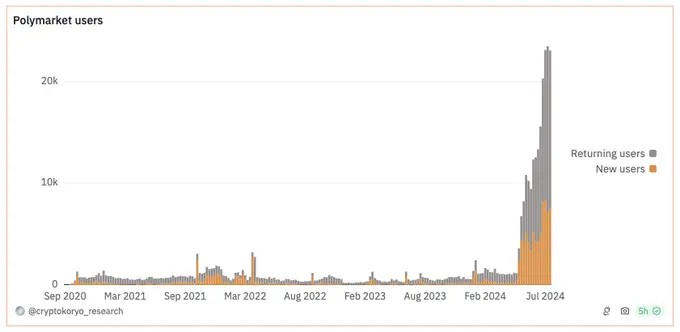
Polymarket’s core mechanics is speculation on real-world events by trading shares in different outcomes. Users buy “shares” in event outcomes based on their forecasts or beliefs, with market prices of shares fluctuating according to supply and demand. When the event resolves, those holding shares of the correct outcome get rewarded. All operations are permissionless and automated, since Polymarket is built on smart contracts.
Unlike gambling, shareholders can enter or exit the market at any time before the event’s resolution. Post-outcome, the settlement price for winners is always fixed at $1 per share.
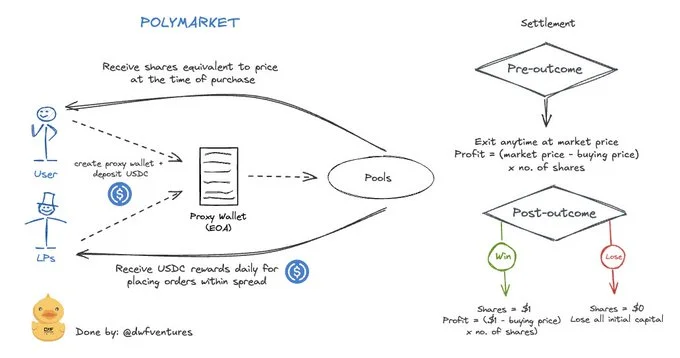
Benefits of Prediction Protocols
Overall, decentralized prediction markets have two key edges over traditional betting platforms:
- Reducing centralization issues. For traditional platforms, the mechanism behind deciding odds and custody of user funds are entirely opaque. In decentralized protocols, odds fluctuate based on user demand with their funds being partially self-custodied, which can be verified on-chain.
- Additional revenue streams for stakeholders. Most traditional platforms have a single counterparty who benefits from users' losses. This is not the case of prediction markets, where liquidity providers (LPs) who bet and, thus, reduce price spreads, get rewarded for their contributions. This has helped prediction protocols bolster trading volume.
To illustrate this point, here is the graph of payouts on Polymarket, which shows that the monthly amount of rewards to LPs has been over $462,000.
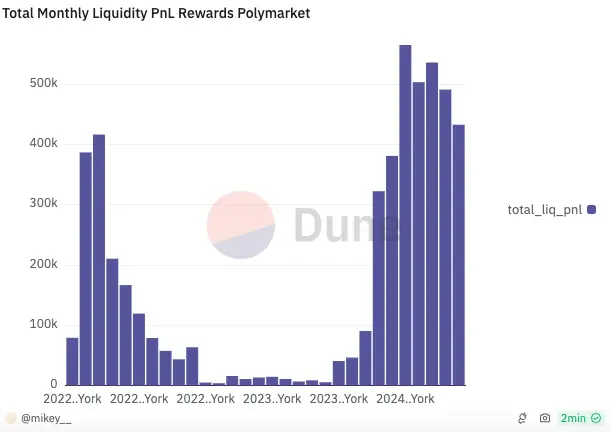
Potential Improvements
Prediction markets are a relatively new niche in DeFi that is still segmented and requires development for higher efficiency.
The first potential space for improvement lies in liquidity. In August 2024, over 80% of bet volume on Polymarket was centered around elections and politics:
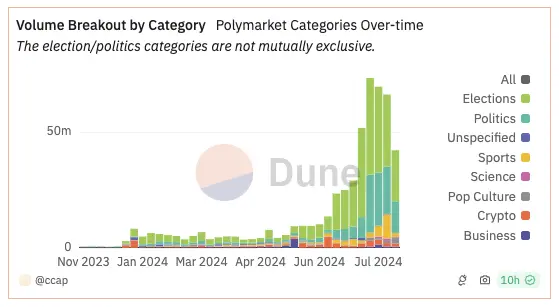
Price spreads on other markets are bigger, which is a disincentive for users. Therefore, this would be an important factor to tackle post-elections.
The second direction of improvement is revamping the resolution process. Currently, Polymarket uses blockchain oracle from the UMA Protocol to decide on outcomes, while disputes are reviewed by a centralized committee.
As few disputes already occurred, having alternate sources and more resolving parties can contribute to further decentralizing the protocol.
Alternatives to Polymarket
Several protocols are introducing new mechanisms to prediction markets. One of them is Swaye, which allows users to create their own markets with shares represented by tokens.
These tokens can be traded even beyond an event resolution, introducing the so-called “unlimited upside” for holders.
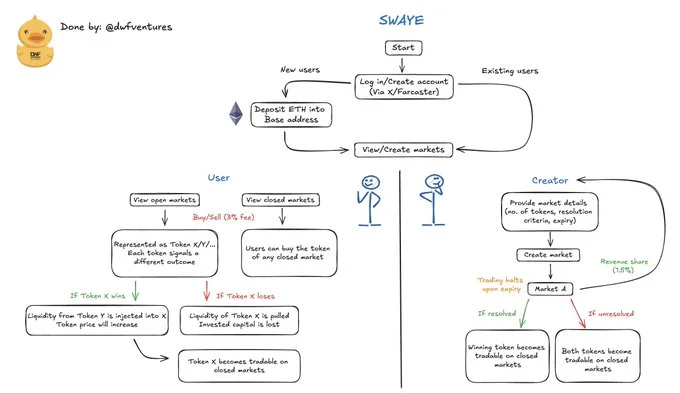
In the meantime, Drift Protocol is rolling out a Solana-based prediction market on their platform, allowing for deeper liquidity and hedging strategies for users. It promises better UX with the potential integration of Blinks, making users bet in one click through Twitter. Developed by Dialect, Blinks is a notification tech designed for dapps on Solana that can connect their functionality and data to X.
Overall
We’re confident that the popularity that prediction markets gained in 2024 is not temporary. They are here to stay, as the integration with everyday events broadens their appeal to a wider audience. Going forward, protocols may choose to focus on crypto users through degen features, or capture a larger market by abstracting the crypto process.
Don’t hesitate to reach out to DWF Ventures if you are working on the prediction markets and are looking for a crypto VC partner.
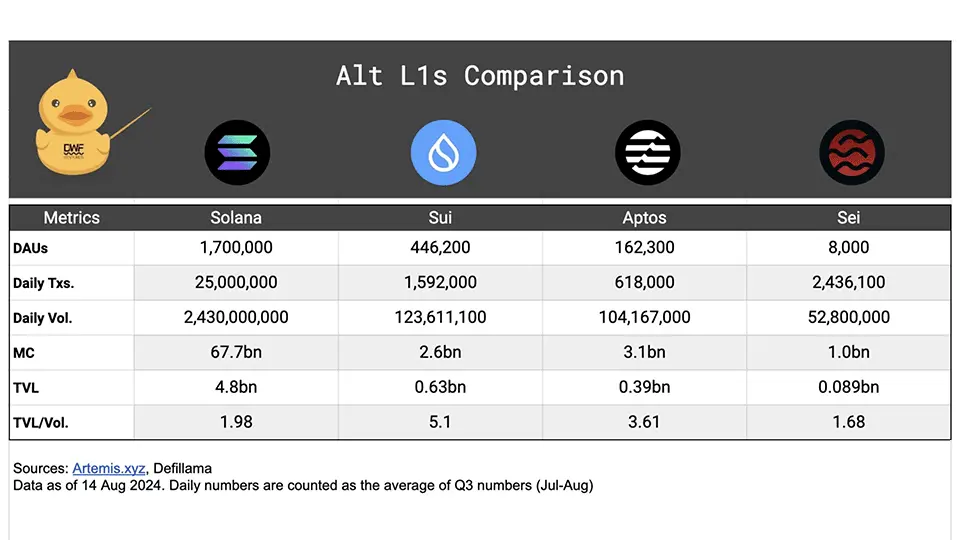
- Details
Some of the recently launched blockchain platforms like Sui, Aptos and Sei try to claim Solana’s title of the fastest blockchain, and become a new basic layer for demanding dapps and DeFi protocols.
As debates heat up regarding which chain could possibly knock Solana off pedestal, we looked into what is happening in these rival networks.
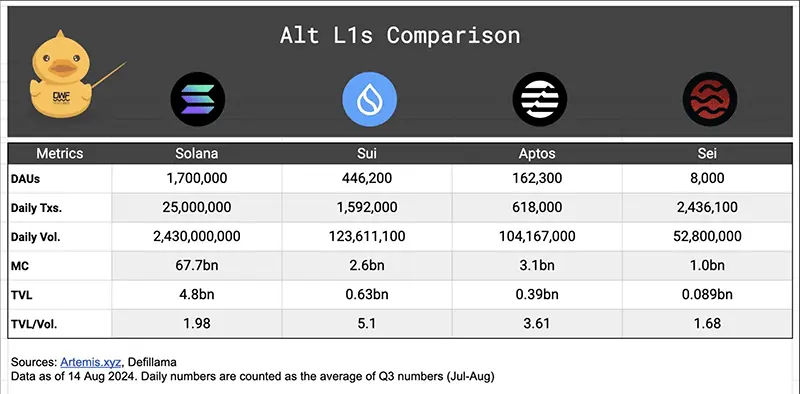
Sui Network
Sui’s native coin has seen significant price action in the past week following heightened mindshare on CT. Top DeFi protocols running on Sui, Navi and Scallop, have seen over $100 million and $50 million increase in TVL respectively, with inflows coming in from Ethereum and other chains:

Despite that, the TVL/volume multiple is still pretty high, signaling that capital in DeFi is mostly idle in pools without much trading activity.
Judging by the number of daily active addresses, the most popular dapp on Sui right now by far is Wave, a Telegram-based wallet with built-in swaps and games.
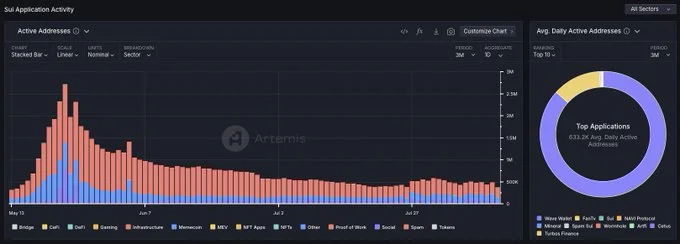
Aptos
Aptos had experienced significant growth earlier this year, with more DeFi and RWA apps coming onboard. Additional inflows followed after the recent launch of USDY. Operated by Ondo, USDY is a “tokenized note” collateralized by short-term T-bills. However, bringing more TVL and further DeFi activity would require more go-to-market efforts.
Sei Network
Despite launching v2 in May, which introduced the EVM compatibility to this blockchain, user activity on Sei has been declining since the start of the year. While Sei’s TVL is increasing, trading volume in DeFi and NFT protocols is dropping.
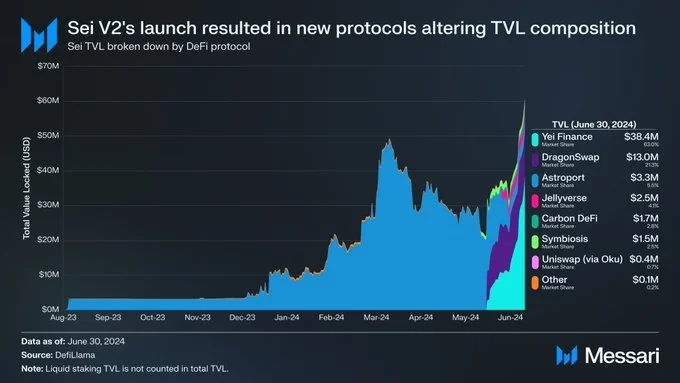
Nonetheless, the team has been making efforts to onboard more developers to the ecosystem by giving out grants, as well as launching liquidity incentive programs for current dapps.
Overall
While alternative L1 blockchains are catching up in economic and user activity, as we showed in this article, Solana not only remains the king among rapid networks but is continue to expand, threatening Ethereum in DeFi and NFT markets. With strong partnerships and regional developer communities, Solana continues to grow from strength to strength. It will be interesting to see what other L1s can do to take a share of the pie.
If you are searching for a crypto VC partnership for your startup working on either of these chains, feel free to reach out to DWF Ventures.
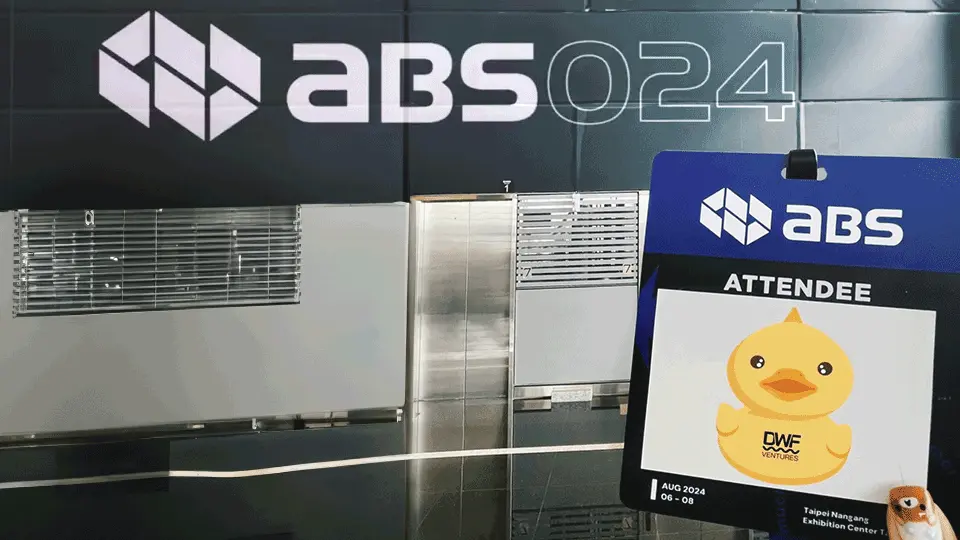
- Details
The team of DWF Ventures joined the crypto community gathered in Taipei for Asia Blockchain Summit 2024 (ABS 2024), where the TON ecosystem also hosted The Open Summit, and composed the key highlights from the events.
Market Sentiments
Narratives
Some significant narratives that had driven the crypto market in the first 3 quarters of 2024, such as restaking, parallel execution, AI, Bitcoin L2s, and more, have slowed down, especially as the altcoin market has not fully recovered yet.
Back to the Fundamentals
When the market sentiment becomes less exuberant, the community tends to take a more conservative approach. People begin shifting their focus away from hype and speculation, and towards more fundamental work, such as improving protocol designs, building the product, and driving real-world adoption.
Crypto Liquidity
New Sources of Liquidity
The crypto market is hoping for the next major influx of liquidity that will drive the space forward, especially when the approvals of BTC and ETH ETFs have not injected as much new capital as many had hoped.
Altcoin Supply
Although overall liquidity in crypto has increased, it has not been able to keep pace with the growing supply of altcoins being released.
Next Catalysts
In the upcoming months, the key catalysts that the community is closely watching for are the potential Fed rate cut and the US election.
Crypto Venture Capital Consensus
VC Deployments
A decent amount of crypto venture capital (VC) firms have slowed down the pace of capital deployment. Despite that, DWF Ventures remains active in seeking out good and reasonably-valued investment opportunitiesL.
Interest in TON
Many venture capitalists, including those based in the United States, are displaying interest in exploring the potential of the TON ecosystem and projects on top of it. However, plenty of them are still trying to figure out which verticals and projects are worth investing in.
TON Ecosystem
Listing on Binance
Listing of Toncoin (TON) on the Binance exchange during The Open Summit became excellent news for the participants, elevating the overall market sentiment around the project.
Growth of Developer Community
The number of those building on TON rapidly grew in the last two quarters, and the most significant increase comes from Chinese developers. They brought new solutions for onboarding retail users. For example, Catizen added the daily on-chain check-in technique into the game and used TikTok-style of viral short videos as a marketing tool. In addition, communities like TONX are making an effort to grow the network of builders on TON.
Mini Apps Thesis
TON aims to maximize their influence through mini apps and Telegram's distribution channel. To leverage game development resources needed for achieving that goal, the ecosystem has recently unveiled strategic partnerships with Cocos Engine and Tencent Cloud. Furthermore, Catizen launched the Catizen Game Center on TON, featuring over 200 mini-games for end-users.
Beyond Tap-to-Earn
While TON is known for their tap-to-earn games like Notcoin and Hamster Kombat, the ecosystem encompasses a wider range of verticals that are worth observing. These include WeChat-style mini-games, short video streaming, social platforms like dating, etc.
DeFi
DeFi on TON is developing gradually with room left for further improvement. Ecosystem’s TVL growth and the issuance of Tether helped to expand the adoption of DeFi sector in TON.
Taiwan Crypto Community
Builders-Driven
In Taiwan, there are more blockchain developers and entrepreneurs than venture capitalists or crypto institutions. Many of them work for major ecosystems like Solana and Sui Network, aiming to scale the local community for the chain.
KOL Community
The KOL culture is particularly popular in Taiwan. Therefore, it is very common to see X and Youtube influencers within the ranks of the local crypto community.
What's Next?
DWF Ventures will be attending and presenting at the upcoming Token 2049 conference in Singapore on September 18-19, 2024. As an active investor in the crypto space, we are eager to connect with founders and ecosystem builders at the event.
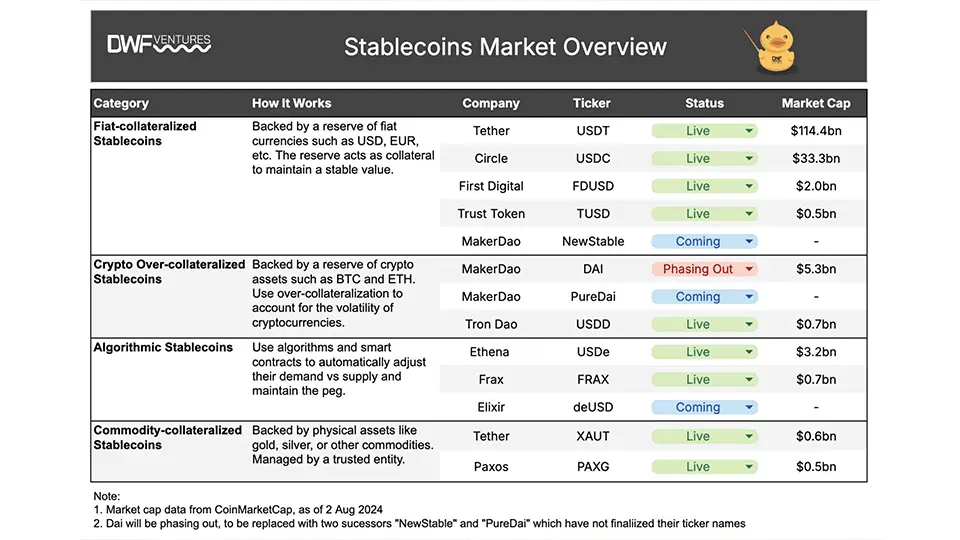
- Details
The stablecon market is getting momentum, highlighted by Tether’s recent announcement of a $5.2 billion net profit in just the first half of 2024, and the speculation surrounding Circle’s potential IPO. DWF Ventures conducted a market analysis and made a table to classify stablecoins, explain their distinctions, and highlight the most notable players in the space.
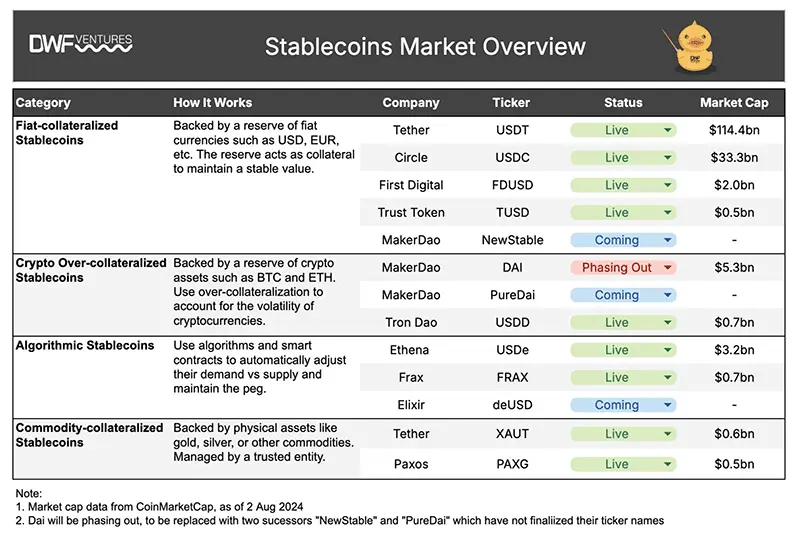
Stablecoins Market Size
The stablecoin market has experienced significant growth, with total capitalization exceeding $160 billion, an increase of $41 billion since October 2023.
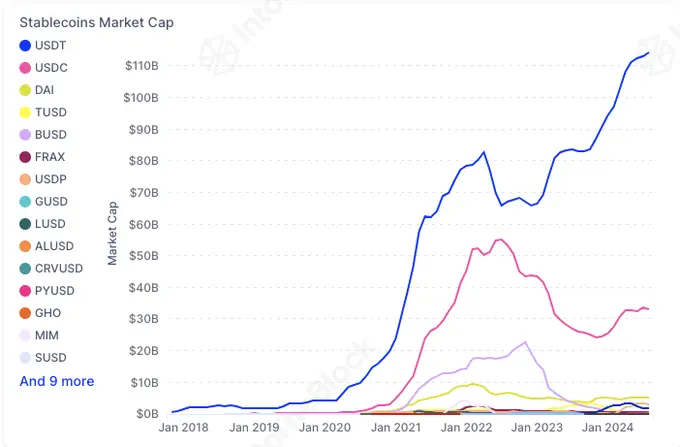
This upward trend reflects the increasing flow of capital into cryptocurrencies, underscoring the critical role stablecoins play as a substitute for “cash” within the digital asset ecosystem.
Tether: Market Leader
Boasting a $114 billion cap, Tether dominates the stablecoin sector, holding nearly 70% of the market share. Although Circle grew rapidly between 2020 and 2021, Tether has outpaced it and other competitors since mid-2022, reclaiming its leading position.
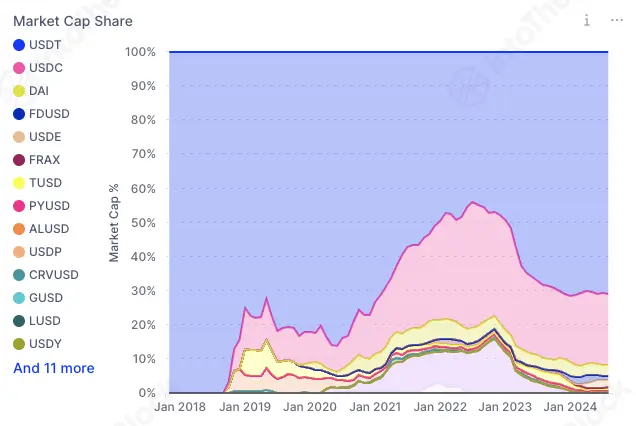
Recently, the company made headlines with an impressive attestation report. It revealed a net profit of $5.2 billion in the first half of 2024, and almost $98 billion worth of U.S. treasuries sitting on its balance sheet, more than Germany. These figures demonstrate their enormous cash-generating capacity.
Types of Stablecoins
Depending on the collateral structure, stablecoins can be classified into several categories:
- fiat-collateralized stablecoins;
- crypto over-collateralized stablecoins;
- algorithmic stablecoins;
- commodity-collateralized stablecoins.
Fiat-Collateralized Stablecoins
The most common and widely used stablecoins are backed 1:1 by traditional fiat currencies such as the U.S. dollar. Key examples include Tether’s USDT, USD Coin (USDC), First Digital USD (FDUSD), and TrueUSD (TUSD). MakerDAO, the platform behind the decentralized stablecoin DAI, plans to launch a new stablecoin, NewStable, aimed at institutional liquidity.
Crypto Over-Collateralized Stablecoins
These stablecoins are backed by reserves of cryptocurrencies like Bitcoin (BTC) and Ethereum (ETH), often using over-collateralization to address the price volatility of crypto assets. Examples include USDD and DAI, though DAI is set to be replaced by PureDai.
Algorithmic stablecoins
Algorithmic stablecoins use algorithms and smart contracts to automatically adjust supply and demand to maintain their peg. Notable examples include USDe and FRAX. A new entrant, Elixir, has introduced a “delta-neutral” and “yield-bearing” stablecoin called deUSD.
Commodity-Collateralized Stablecoins
Crypto assets backed by physical assets like gold, silver, or other commodities represent a separate kind of stablecoins. The reserve of such stablecoins is usually managed by a trusted entity. Examples include Tether Gold (XAUT) and Pax Gold (PAXG). Even though the adoption has been slower for commodity-collateralized stablecoins, it is steadily increasing.

What's Next?
Stablecoins are a critical driver of growth in the broader cryptocurrency market, and their expansion is expected to continue. And soon, there will be one more player in this field. DWF Labs’s Managing Partner, Andrey Grachev, recently hinted at the company’s upcoming project: a CeDeFi synthetic stablecoin that will combine yield generation with risk management and regulatory compliance. With this move, our company continues the road to becoming a global web3 financial institution.